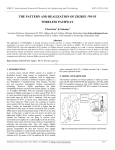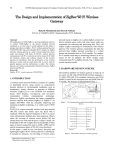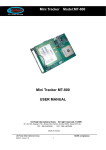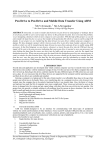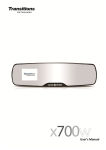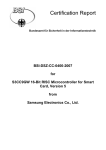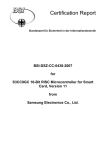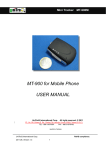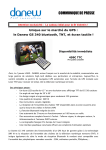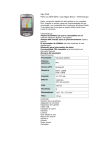Download (Patient Monitoring System) Based on Embedded Linux
Transcript
Advance in Electronic and Electric Engineering. ISSN 2231-1297, Volume 3, Number 5 (2013), pp. 633-640 © Research India Publications http://www.ripublication.com/aeee.htm i Design and Implementation of a Four Parameter PMS (Patient Monitoring System) Based on Embedded Linux Sramika Reddy.P# and Narayanaraju Samunuri*2 Sreenidhi Institute of Science and Technology, #M.Tech & VLSI-ES & Department of ECE & JNTU-Hyderabad, India. Abstract The opportunity for alcohol addict ant patients to have real-time constant monitoring of their health state is now possible by means of a portable and simple-to-use device. This allow one to get preliminary domestic diagnoses of vital parameters like pulse rate, body temperature, oxygen saturation (%SPO2) and blood alcohol levels. In this project an attempt has been made to design and develop a monitoring system for medical applications. The real-time processing and analysis of parameters such as pulse rate detection, pulse oximeter, body temperature data are taken from the application modules for transforming and storing using ARM 9. The projected device is a patient-adaptive embedded system able to provide clinical diagnoses of the monitored patient’s data to the doctor. The Nellcor module produces SPO2 as well as pulse rate with the help of a finger sensor and other temperature sensor ,alcohol sensor has the task to acquire, condition, and sample the analog electrical impulses, whereas an embedded system performs the diagnosis according to the measurement uncertainty and transferred to the doctor through LAN . The medical staff can check out the data through their PC any where from the hospital. The system shows the real time clinical data of the patient continuously through internet (LAN connection). Keywords: ARM Controller, Monitoring System, Nellcor module ,Temperature, Alcohol sensor, LAN. 634 Sramika Reddy.P & Narayanaraju Samunuri 1. Introduction The opportunity for patients to have constant monitoring of their health state is now possible by means of telemedicine applications. The continuous monitoring of the health status is a fundamental practice for patients suffering from various diseases and especially liver patients. For these patients, it is necessary to constantly keep under control their health activity to prevent the occurrence of a specific pathology. In fact, by continuous and regular monitoring of the heart rate, body temperature, SPO2, blood alcohol levels it is possible to make timely diagnoses on a potential abnormality.The data is transformed using UART to ARM9 .There are many monitoring systems in the market more economic depending on their accuracy. The suggested approach in this paper is to reduce the economic cost and provide more accuracy using an embedded system. The embedded system [2] is dedicated to specific tasks, which can optimize, reduce the size and economic cost of the product and increase the reliability and performance .The real-time processing and analysis of multi-parameters such as pulse rate detection, SPO2, body temperature, blood alcohol data are taken from the application modules for transforming and storing using SC32440 ARM 9 core processor. The transformed data is transferred to the doctor through Ethernet to PC. 2. Implementation The system implementation consists of both hardware and software. 2.1 Hardware approach The hardware design constitutes of S3C2440 ARM9 processor with SERIAL PORT , nellcor module MP-506 with a finger sensor ,TEMPERATURE SENSOR (LM35) ,alcohol sensor (MQ 3) , PC 1,PC 2 (provided with LAN connection) they are connect as shown in figure 1. Fig. 1:Overall System Block Diagram. Design and Implementation of a Four Parameter PMS 635 1. S3C2440 ARM PROCESSOR: The Implementation of drivers to touch panel for the Samsung's S3C2440 is to be develop ARM9 architecture and Samsung's S3C2440A 16/32-bit RISC microprocessor Samsung’s S3C2440A[3] is designed to provide hand-held devices and general applications with low-power, and provides high-performance micro-controller solution in small die size. The ARM processor is a Reduced Instruction Set Computer (RISC). The S3C2440 is a 32 bit microcontroller that internally integrates ARM920T of the ARM Company [9]. ARM920T implements 5-stage pipeline architecture and separate 16KB Instruction cache and 16KB Data cache which are used for faster performance. The S3C2440 have some integrated on-chip functions such as LCD controller, RAM controller, 3 paths UART, 4 paths DMA, 4 path with PWM of Timer, parallel I/O port, 8 channels of 10-bit ADC, the interface of touch screen, I2C interface, two USB interface controllers, two channels SPI, the main frequency of S3C2440 up to 400mhz [4]. The Figure. 2 show the MINI2440 on-board peripherals layout. 2 Universal asynchronous receiver/transmitter (UART): It facilitates communication through a computer's serial port using the RS-232C protocol. The UART performs the serial-to-parallel conversion on data received from a peripheral device and also parallel-to-serial conversion on data transmitted to the peripheral device. The CPU can read and write data and control/status information through the AMBA APB interface. The transmit and receive paths are buffered with internal FIFO memories [9] Enables up to 16-bytes to be stored independently in both transmit and receive modes.The UART consists of a programmable baud rate generator that generates a common transmit and receive internal clock from the reference clock input of uart ,UARTCLK and it offers similar functionality to the industry-standard 16C550 UART device also supports baud rates up to 460.8Kbits/s, which subject to UARTCLK reference clock frequency. 3. Ethernet Rj-45: Ethernet is a physical and data link layer technology for local area networks (LANs). Ethernet Interface: An 10/100M self-adapting ethernet chip DM9000 and a ethernet connector RJ45 are used on the MINI2440[7]. The RJ45 connector contains a coupled inductor, therefore we do not need a network transformer but a simple ethernet cable to connect the MINI2440 development board to a router or switch. 4. ADC This is used to convert the analog data to the digital format .It has 10 bit resolution ADC with 8 channel analog input . its maximum conversion range is 500KSPS. On the MINI2440, totally there are 4 A/D conversion channel which are located on the CON4-GPIO interface. The analog data values are taken from the temperature sensor LM35 and alcohol sensor MQ 3. 636 Sramika Reddy.P & Narayanaraju Samunuri 5. Temperature Sensor (Lm35): Fig. 2: Temperature Sensor. This is used to measure the body temperature in degree centigrade. LM 35 is the efficient and standard sensor from ATMEL .The LM35 can operate over a −55°C to +150°C temperature range (as shown in figure 2) which is connected to ADC 0 port .The data is taken from the sensor to the ADC of ARM 9. 6. Alcohol Sensor (MQ3): Fig. 3: Alcohol Sensor. The figure 3 shows Alcohol sensor MQ-3 which has very high sensitivity, and has good resistance in disturbance OF gasoline, smoke and vapour. The sensor could be used to detect alcohol with different levels of concentration with low cost and suitable for different application. The data is collected from the alcohol sensor to ADC when there occurs change in the sensor. 7. Nellcor Module with a finger sensor: Nellcor module MP-506 is used to detect the pulse rate and blood oxygen based on pulse oximetry from the patient with the help of a finger sensor. Pulse Oximetry is the non-invasive measurement of the oxygen saturation (SpO2). Oxygen saturation is defined as the amount of oxygen dissolved in blood which is based on the detection of Haemoglobin and Deoxyhemoglobin[4]. Two different light wavelengths red and infrared are used to measure the actual difference in the absorption spectra of HbO2 and Hb. The bloodstream is affected by the levels of concentration of HbO2 and Hb , and their absorption coefficients are measured using two wavelengths 660 nm (red lightspectra) and 940 nm (infrared light spectra). Deoxygenated hemoglobin (Hb) has a higher absorption at 660 nm and oxygenated hemoglobin (HbO2) has a higher absorption at 940 nm shown in figure4. Design and Implementation of a Four Parameter PMS 637 Fig. 4: Hemoglobin light absorption graph and protocol used. A photo-detector in the sensor perceives the non-absorbed light from the LEDs. This signal represents the light that has been absorbed by the finger and is divided in a DC component and an AC component. The pulse oximeter analyzes the light absorption of two wavelengths from the pulsatile-added volume of oxygenated arterial blood (AC/DC) and calculates the absorption ratio This value represents a ratio of reduced to oxygenated haemoglobin. Using this oxygen saturation is calculated based on empirical data. Spo2=110-25 X R 3. Connections: The MP 506-SPO2 was designed for working with Nellcor-DS100 series sensor. The sensor is connected to the board through a simple pin connector, similar to the one used in the RS232 communications standard. The analog data is taken from the finger sensor and DS100 series sensor is connected to nellcor module where the digital conversion of data is done. The saturation blood oxygen and pulse rate are identified now, when the heart pumps a pulse of blood through blood vessels, the finger has slight movement in light reached the detector. With each change in heart pulse the detector signal varies. This varied signal is converted to electrical pulse. This signal is amplified through an amplifier which outputs +5V logic level signal[5][10]. 4. Protocol: The data from nellcor is sent to ARM kit through UART serial data transmission using a protocol which is SHIP protocol .It is Standard Host Interface Protocol. This is a 8bit protocol . STX indicates the start of transmission with 0X02 and D1…DN is DATA which consists of spo2 and pulse rate[6]. CRC is cyclic redundancy check which is used to detect the errors in the data if found it will ask the nellcor to resend the data of the patient. ETX is the end of transmission . 638 Sramika Reddy.P & Narayanaraju Samunuri B.SOFTWARE APPROACH: The software approach is entirely based on : • Linux platform • Python 2.7 for obtaining data on the browser. The requirement to work with ARM 9 microcontroller are : Installing Linux on MINI2440 and Installing Tool chain with Boot loader, Kernel and Root File System and Porting Linux. For developing applications like body temperature, pulse rate , blood alcohol, blood saturation the ARM GNU compiler is used to generate the three .elf32 files which are dumped on to ARM9 kit[8]. 5. Results The entire connected ARM kit when connected to a PC a terminal 1.9v is downloaded is opened and connected as shown in figure5 then the steps involved are: Fig. 5, 6: Hardware Setup and Display on Browser Using Python 3. Power on ARM kit and PC • • • • • Open terminal.exe on PC Press connect on terminal screen Buildroot login: root # cd flaskr python app.py Terminal to browser using python: This is done using python open source file Python: This can interface and run on all hardwares. This is used to read the terminal data on to the browser with an IP address. The results are shown in figure 6. The results of temperature ,blood alcohol ,SPO2, pulse rate are found on the browser page . Design and Implementation of a Four Parameter PMS 639 The network of a system with a LAN connection can make use of any system to look after the patient data by the doctor . This data is sent to the doctor continuously without any delay in the system provided continuous power supply and Ethernet connection. 4. Conclusion: The proposed system Design and Implementation of a Four Parameter PMS (Patient Monitoring System) Based On Embedded Linux WAS TESTED and the results are obtained on the browser for the doctor’s view. The work includes both transferring data and receiving data from patient to the doctor continuosly. 5. Future Scope This system can also include other parameters like ECG, respiratory sensors and the error correction of data can be implemented in nellcor module. References [1] [2] [3] [4] [5] [6] [7] Samsung Electronics Co.Ltd.S3C2410A user's manual, revision 1.0[EB/OL]. Yongin City, GyeonggiDo, Korea [2004-03]. SAMSUNG: S3C2410X Data Sheet. 2003 Zhou Pengshuo, Wang Ziqiang, Zhou Yu, DuSidan.“Data collecting terminal with wireless networking support baseon S3C2410 and Linux2.6,” Electronic measurement technology ,Vo31.No 1,2008. Lubrin E, Lawrence E, Navarro KF (2005). Wireless Remote Healthcare Monitoring with Motes. Proc. IEEE Int. Conf. Mobile Bus. (ICMB'05), Sydney, Australia, pp. 235- 241. Pierce F (2001). A protocol-centric approach to healthcare information technology. CBMS 2001. Proc. 14th IEEE Symp., DOI: 10.1109/CBMS.2001.941765, pp. 481486. David Culler, Deborab Esrtin, Mani Sivastava. “Overview of Sensor Networks”, IEEE Computer Society, August 2004 Ch. Sravani, N.V.Narayana Rao / International Journal of Engineering Research and Applications Vol. 2, Issue 1,Jan-Feb 2012, pp.863-869, Jain, N.P. ; Jain, P.N. ; Agarkar, T.P. Information and Communication Technologies (WICT), 2012 World Congress on Digital Object Identifier: 10.1109/WICT.2012.6409218 Publication Year: 2012 , Page(s): 987 – 992 640 Sramika Reddy.P & Narayanaraju Samunuri IEEE Conference Publication [8] Joshi, V. ; Moradshahi, P. ; Goubran, R. [9] Medical Measurements and Applications Proceedings (MeMeA), 2013 IEEE International Symposium on [10] Digital Object Identifier: 10.1109/MeMeA.2013.6549765 Publication Year: 2013 , Page(s): 345 - 349 Author’s Biography Sramika Reddy.P pursuing M.Tech in VLSI & Embedded Systems (VLSI-ES), Department of ECE, Sreenidhi Institute of Science and Technology. Narayanaraju Samunuri, M.Tech in Embedded Systems, with an experience of 11 years in Core Embedded System domain, published International paper on Flex ray Communication and Implementation of RegisteFilesin the Processor of Hard Real Time Systems for Context Switching.











